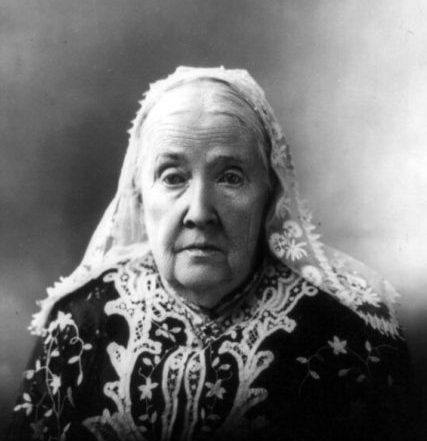New Orleans Women’s Book Clubs
In the late nineteenth and early twentieth centuries, women’s book clubs became increasingly popular in New Orleans.

Courtesy of Library of Congress Prints and Photographs Division.
A black and white reproduction of a 1902 photograph of Julia Ward Howe.
In the late nineteenth and early twentieth centuries, women’s book clubs became increasingly popular in New Orleans. Concurrently, women journalists, editors, and fiction writers became more numerous and influential, on both a national and regional level. Eliza Nicholson, for example, became editor of the New Orleans Times-Picayune during these years, and Kate Chopin’s local color fiction appeared on the national literary scene. In addition, the founding of Tulane University and the opening of the World Cotton Centennial Exposition, both in 1884, brought new ideas and people into the Crescent City. Tapping into this intellectual energy, several visionary and well-connected women spearheaded literary gatherings that transformed the city’s cultural life. Though initially begun by women primarily for women, these groups eventually expanded to include men as well. In a conservative region, book clubs often provided a supportive environment for those willing to challenge traditional gender roles in general, and women’s exclusion from the public sphere in particular.
The Early Years: The Pan Gnostics, the Quarante Club, and Mollie Moore Davis’s Salon
Bostonian Julia Ward Howe played a central role in one of the most interesting and formative literary clubs, the Pan Gnostics. Howe, who came to New Orleans as head of the Woman’s Department of the 1884 World Cotton Centennial exposition, resuscitated a book club established by John Rose Ficklen, professor of history at Tulane University. In club meetings, held at Howe’s house, members read original papers, conversed, and enjoyed light refreshments. Early participants included Howe’s daughter, Maude, the New York poet Joaquin Miller, editor Eliza Nicholson, and writer Grace King. King delivered her first paper, “Heroines of Novels,” at one of the Pan Gnostics’ meetings. Published in the New Orleans Times-Democrat in 1885, the paper launched her long literary career.
During this same decade, the Quarante Club, which is still in existence, was founded as a center for women writers. Mary Ashley Townsend, a native New Yorker, helped found the group and became an important cultural force herself. Originally consisting of only forty members, the club’s reading list included Victorian poets, Shakespeare’s history plays, and eighteenth-century French, German, and English writers. Other founding members included writers Grace King, Ruth McEnery Stuart, and Mollie Moore Davis.
Mollie Moore Davis also hosted a Friday afternoon salon at her Royal Street apartment. Established in 1885, it became a gathering place for Tulane faculty, newspaper staff, northern editors, writers—such as Kate Chopin, George Washington Cable, Lafcadio Hearn, and Thomas Nelson Page—and members of other women’s clubs. A vital force in the city’s cultural life, Davis brought together an eclectic mix of Anglo-American, Creole, northern, southern, and European visitors, many of whom contributed to the careers of local writers. She modeled these gatherings on European salons whose primary purpose was to facilitate conversation among men and women “of brains and wit,” in her words. Unlike earlier women’s clubs, Davis’s salon focused on spirited conversation, excluding dancing, elaborate refreshments, and formal programs. The social interaction with, and exposure to, an international guest list provided a nurturing intellectual community for fledgling women writers such as Chopin and King.
The Early Twentieth Century and Le Petit Salon
In New Orleans, one of the most instructive developments in the women’s literary club movement was the formation of Le Petit Salon in 1924. Readings, musical performances, lectures, and excerpts from plays formed the salon’s weekly fare. Begun as an informal gathering after the dramatic performances of Le Petit Theatre, the salon evolved to become one of the significant historic preservation communities in the French Quarter. With Grace King as its first president, and Dorothy Dix as vice-president, the salon played a major role in the area’s cultural revival. In 1925, the group bought a 1838 Greek Revival mansion built by hardware merchant Victor David. Adjacent to Le Petit Theatre at 620 St. Peter Street, the house became the salon’s permanent home. Architectural historians credit the group with initiating the restoration and rehabilitation of the French Quarter by purchasing one of its most valuable historical structures.
